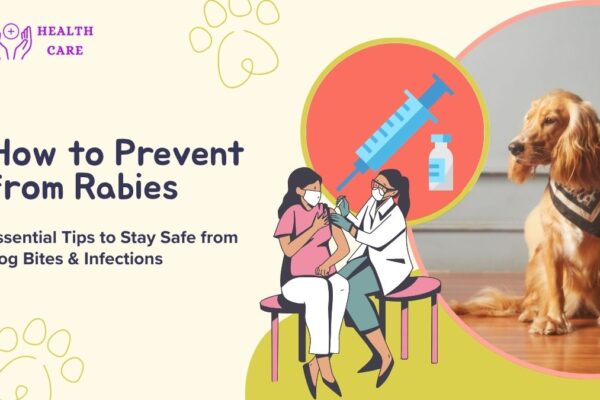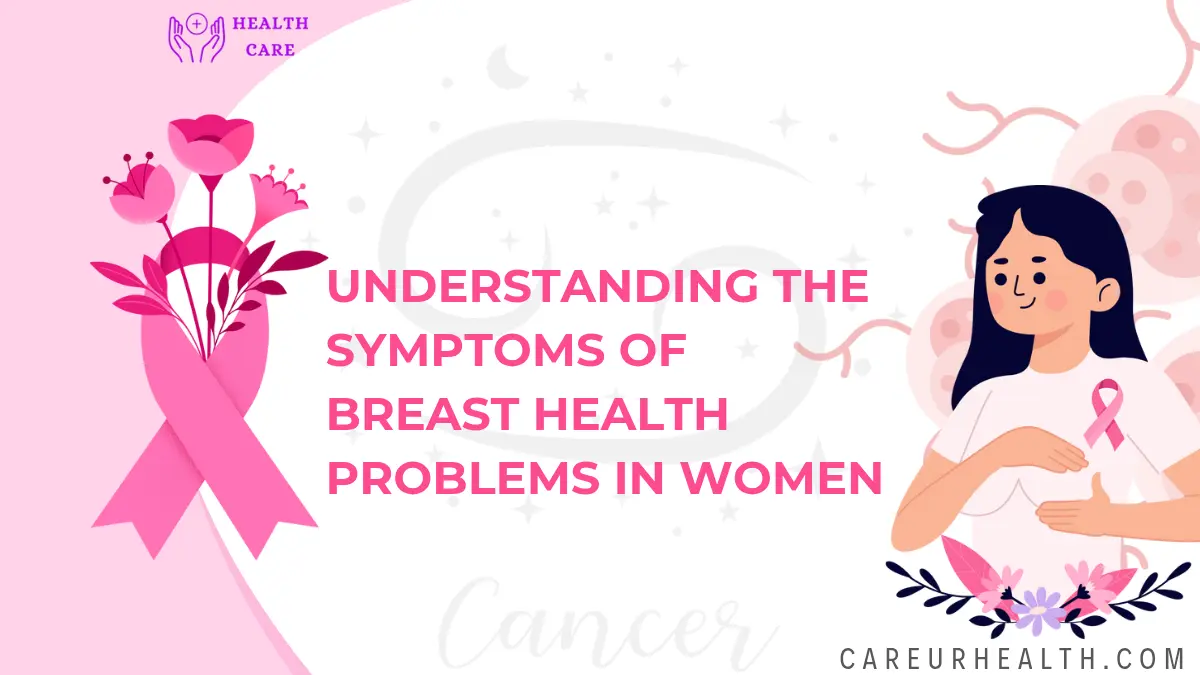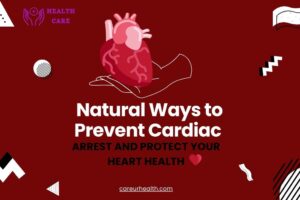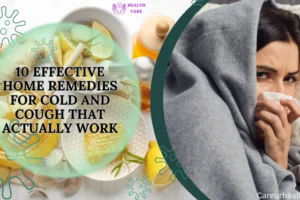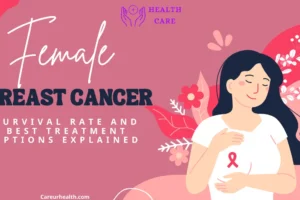Breast cancer is a kind of cancer that begins as a growth of cells in the breast tissue.
After skin cancer, breast cancer is the most common cancer diagnosed in women in the United States. But breast cancer doesn’t just happen in women. Everyone is born with some breast tissue, so anyone can get breast cancer.
Breast cancer survival rates have been increasing. And the number of people dying of breast cancer is steadily going down. Much of this is due to the widespread support for breast cancer awareness and funding for research. Lets talk about symptoms of Breast Health Problems in Women.
What is breast Cancer?
Breast cancer occurs when cells in the breast grow abnormally and in an uncontrolled way. This form a cancerous lump, known as a tumour. If left untreated, breast cancer may spread from breast tissue to other parts of the body, such as the bones, liver or lungs.
Breast cancer affects both males and females, although it is much less common in males.
There are some pre-cancerous breast conditions, also referred to as ‘pre-invasive’ or ‘carcinoma in situ’. This is when there are abnormal cells inside the milk ducts or milk-producing lobules of the breast, but not into nearby tissue. There could be many symptoms of Breast Health Problems in Women.
What kinds of cells are involved in the breast cancer?
Pathologists in the lab look at the kind of cells that make up the breast cancer. Kinds of cells include:
- Ductal cells. Ductal breast cancer, also called ductal carcinoma, is the most common type of breast cancer. This type of cancer starts in cells in the lining of a milk duct within the breast. The ducts can carry breast milk to the nipple.
- Lobular cells. Lobular breast cancer, also called lobular carcinoma, starts in the lobules of the breast. The lobules can make breast milk. The lobules are connected to the ducts, which can carry breast milk to the nipple.
- Connective tissue cells. Rarely, cancer in the breast is made up of connective tissue cells. Connective tissue includes the muscles, fat and blood vessels. Examples of rare breast sarcomas include angiosarcoma and leiomyosarcoma.
- Lymphatic system cells. Lymphoma is a cancer that starts in the cells of the lymphatic system. Very rarely, lymphoma can start in lymphatic system cells in the breast. Most breast lymphomas are a kind of non-Hodgkin lymphoma.
Types of breast Cancer
There are many different types of breast cancer, each of which is decided by the location in the breast where it begins to grow. How much the cancer has grown or spread, and certain features that influence how the cancer behaves. Knowing the type of breast cancer you’ve been diagnosed with helps you. And your doctor choose the best treatment options for you.
Invasive breast cancer
When breast cancer is called invasive (or infiltrating), it means it has spread into the surrounding breast tissue. The two most common types of invasive breast cancer are defined by where in the breast they begin to grow:
- Invasive ductal carcinoma (IDC) is invasive breast cancer that starts in the milk ducts, the tubes that carry milk from the lobules to the nipple. It is the most common type of breast cancer; about 80% of all breast cancers are invasive ductal carcinomas.
- Invasive lobular carcinoma (ILC) is invasive breast cancer that starts in the lobules, the glands in the breast that produce milk. It is the second most common type of breast cancer; about 10% of all invasive breast cancers are invasive lobular carcinomas.
Invasive breast cancer have features that affect development and treatment :
- Triple-negative breast cancer is an aggressive type of invasive breast cancer that tests negative for estrogen receptors and progesterone receptors and doesn’t have extra HER2 proteins. About 12% of all invasive breast cancers are triple-negative.
- Triple-positive breast cancer tests positive for estrogen receptors and progesterone receptors and has too many HER2 proteins. About 10% of all breast cancers are triple-positive.
- Inflammatory breast cancer is a rare and aggressive type of invasive breast cancer. About 1% of all breast cancers in the United States are inflammatory breast cancer.
- Metastatic breast cancer, also called stage IV breast cancer, is invasive breast cancer that has spread (metastasized) to parts of the body away from the breast, such as the bones, liver, lungs, or brain.
- Male breast cancer is rare, but it does happen. Most male breast cancers are invasive ductal carcinomas.
- Paget disease of the breast is a rare form of breast cancer where cancer cells collect in or around the nipple.
Early warning signs of invasive breast cancer
- Symptoms more specific to invasive breast cancer are:
- Irritated or itchy breasts are symptoms of Breast Health Problems in Women.
- Change in breast color are symptoms of Breast Health Problems in Women.
- Increase in breast size or shape (over a short period of time) are symptoms of Breast Health Problems in Women.
- Changes in touch (may feel hard, tender or warm) are symptoms of Breast Health Problems in Women.
- Peeling or flaking of the nipple skin are symptoms of Breast Health Problems in Women.
- A breast lump or thickening are symptoms of Breast Health Problems in Women.
- Redness or pitting of the breast skin (like the skin of an orange) are symptoms of Breast Health Problems in Women.
Symptoms of breast cancer can include:
- A lump or area of thickened tissue in the breast (especially if only on one side) are symptoms of Breast Health Problems in Women.
- A change in the size or shape of one or both breasts are symptoms of Breast Health Problems in Women.
- A change in the shape or appearance of the nipple, such as crusting, sores, redness or inversion (where the nipple turns in instead of pointing out) are symptoms of Breast Health Problems in Women.
- Changes to the skin of the breasts, such as dimpling (looking like an orange peel), indents, rash or redness are symptoms of Breast Health Problems in Women.
- Discomfort or swelling in one armpit are symptoms of Breast Health Problems in Women.
- Pain in one breast that is not related to your menstrual cycle or continues after your period are symptoms of Breast Health Problems in Women.

Tips for preventing breast cancer
Practice Breast Health Screenings
You know that regularly checking your breasts for signs of abnormalities is important, but how many times would you say you do this throughout the year? Don’t beat yourself up about it. Instead, tell yourself this is the day that changes!
Regularly checking your breasts once a month can help you detect early signs of cancer. It’s a good idea to set a reminder on your smartphone, so you remember to do this at the same time each month (typically 7-10 days after your period). Follow this to avoid symptoms of Breast Health Problems in Women.
Know Your Breasts
As you regularly perform self-exams, you’ll start to become familiar with the size, shape, and texture of your breast. In doing so, you’ll be able to notice if something feels off or if you see discharge, rashes, or lumps appear on your breast.
If you notice a lump or something irregular, contact your doctor to schedule an appointment: “This is especially true for changes that last more than one full menstrual cycle or seem to get bigger or more prominent in some way,” Follow this to avoid symptoms of Breast Health Problems in Women.
Avoid Smoke Cigarettes
Smoking has continually been named a foremost cause of many serious illnesses, including breast cancer.
A California Department of Health Services study found that the rate of breast cancer amongst women smokers was around 30% higher than for those who had never smoked. Follow this to avoid symptoms of Breast Health Problems in Women.
Separate research also suggests that the effects of smoking are cumulative, with risk increasing according to years of cigarette smoking. Hence, quitting now could help cut your risk of developing breast cancer later.
Known Your Family’s History
Be sure to ask your loved ones and relatives if there is any history of breast cancer in the family. According to The American Cancer Society, 5-10% of breast cancer cases are believed to be the result of gene mutations passed down from a parent to a child. Follow this to avoid symptoms of Breast Health Problems in Women.
Be sure to share this information with your doctor, as your clinician may recommend additional preventative measures to help you detect any type of mutation early on.
Exercise/Maintain Healthy Weight
As we mentioned earlier, exercise is essential to your body’s health, especially your breast health. Follow this to avoid symptoms of Breast Health Problems in Women.
Here’s how it works:
Fat cells produce estrogen, and high levels of that hormone have been linked to certain cancers. Staying active can actually shrink the size of fat cells, so your body pumps out less estrogen.
The study recommends getting at least 150 minutes of moderate-intensity exercise per week (ideally, spread out vs. Doing it all at once). Any kind of cardio will do, so hop onto your bike, or hit the nearest hiking trail.
Short on time? Exercising at high intensity for 75 minutes a week will have the same benefit.
Don’t Forget Folic Acid
Not eating enough folate, the naturally occurring form of folic acid, is linked with impaired ability to repair DNA. And damaged DNA has, in turn, been linked to cancer. Follow this to avoid symptoms of Breast Health Problems in Women.
Folate is found in foods, such as spinach and black-eyed peas, as well as in folic-fortified cereals and grains.
Conclusion
Always undervalue the importance of a healthy breast. Even though not every sensation points to a dangerous illness, listening to you’re mind and getting medical help when you need it could have a big impact. Know your symptoms of Breast Health Problems in Women. Women who are knowledgeable, conscious, and watchful were more inclined to identify issues early on, which improves results and brings serenity of minds. You can lessen the judgment and anxiety associated with breast cancer by promoting an environment of candid communication and preventative treatment.
Frequently Asked Questions (FAQs)
- What are the early signs of breast cancer?
Early signs include a new lump in the breast or underarm, changes in breast size or shape, nipple discharge, skin dimpling, or nipple inversion. However, not all lumps are cancerous.
- Is breast pain always a sign of cancer?
No. Breast pain is common and often related to hormonal changes, cysts, or infections.
- What does a cancerous lump feel like?
Cancerous lumps are usually hard, irregular in shape, and immovable. They may or may not be painful.
- Can young women develop breast problems?
Yes. While the risk of breast cancer increases with age, young women can experience conditions like fibroadenomas, cysts, and infections.
- How often should I perform a breast self-exam?
It is recommended to perform a self-exam once a month, preferably a few days after your menstrual period ends when breasts are least tender.




